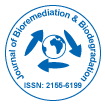Research Article
Evaluation of Stability Factors in the Anaerobic Treatment of Slaughterhouse Wastewater
| Edith Padilla-Gasca, Alberto López-López* and Juan Gallardo-Valdez | |
| Unidad de Tecnología Ambiental, Centro de Investigación y Asistencia en Tecnología y Diseño del Estado de Jalisco, Guadalajara, México | |
| Corresponding Author : | Dr. Alberto López-López Unidad de Tecnología Ambiental Centro de Investigación y Asistencia en Tecnología y Diseño del Estado de Jalisco, Guadalajara, México E-mail: alopez103@yahoo.com, allopez@ciatej.net.mx |
| Received: October 01, 2010; Accepted: February 08, 2011; Published: February 10, 2011 | |
| Citation: Padilla-Gasca E, López-López A, Gallardo-Valdez J(2011) Evaluation of Stability Factors in the Anaerobic Treatment of Slaughterhouse Wastewater. J Bioremed Biodegrad 2:114. doi:10.4172/2155-6199.1000114 | |
| Copyright: © 2011 Padilla-Gasca E, et al. This is an open-access article distributed under the terms of the Creative Commons Attribution License, which permits unrestricted use, distribution, and reproduction in any medium, provided the original author and source are credited. | |
Related article at  |
|
Abstract
The main environmental factors that assured the stability of an anaerobic batch process for the treatment of slaughterhouse wastewater were evaluated. The reactor was inoculated with anaerobic sludge from a distillery wastewater treatment plant. The volume of produced CH4 was proportional to the quantity of organic matter removed matter (measured as Chemical Oxygen Demand, COD). The overall organic matter removal was 75%. The acetic, propionic and butyric acids concentration profiles were similar, where acetic acid had the highest concentration throughout the study period. The response time recorded between the acetogenic and methanogenic stages in this study was two days. The process showed an elevated acidogenic activity of 1.62 g of VFA/g of COD removed and a high Methane Production Rate (MPR) of about 450 ml of CH4/g of COD removed. The anaerobic treatment of slaughterhouse wastewater generated a buffer system which produced sufficient alkalinity to neutralize the effects of Volatile Fatty Acids (VFA) generated during the process.
